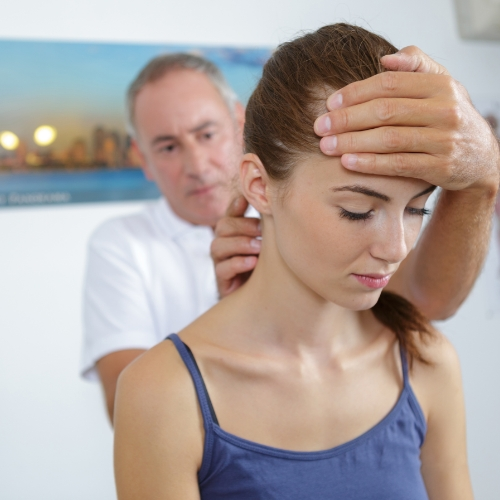
Neuromuscular Re-education consists of:
- Manual techniques (i.e., PNF-proprioceptive neuromuscular facilitation)
- Activities for balance and core control
- Therapeutic exercises that are designed to re-develop normal controlled movement patterns.
To eliminate many of the symptoms that a patient presents with during their treatment time, it is critical to re-establish normal kinesthetic sense and proprioception of the Cervical, Thoracic, Lumbar spine, and Appendicular skeleton. When these neurological characteristics are not functioning properly, a patient cannot maintain proper posture and many of the muscles of the involved area do not function properly. Pain, inflammation, and swelling due to surgery or injury can lead to loss of neuromuscular control and abnormal movement.
Many of our patients have general tenderness and decreased motion of a joint(s). A joint needs to have a full motion to be fully functional. If the joint does have full range of motion, weakness, and functional limitations will develop over time. This period is different for every patient, normally several weeks to months when the symptoms are not treated properly. Any loss of motion and strength needs to be addressed to eliminate the patient’s symptoms and correct the underlying problem. However, re-education of the nervous system must occur before developing enough strength and motion to regain full function. Without the neuromuscular re-education process, “normal” movement patterns are unlikely to be re-established.
Neuromuscular re-education plays a major role in the rehabilitation of our patients. Using the proper techniques, activities and exercises on an injured body part will prevent acute injury from developing into a chronic problem.
At Full Potential Physical Therapy, we look at the patient as a whole and address all aspects of the dysfunction to help the patient achieve her or his maximal rehabilitation potential, and to be the best they can be in performing all of their functional activities. Request an appointment today at our Holland, MI location.
Neuromotor Re-education
NMR is a mouth full to digest as a PT treatment concept. It consists of exercises that help the patient to progress from simple movements to ones that progressively require more control and stability. Through this process, the nervous system’s ability to communicate to muscles progressively improves to affect stability, balance, coordination, and ultimately function. The re-education process helps a patient develop more efficiency in their movements to reduce stress on painful joints and tissues. This can dramatically improve someone’s quality of life as chronic joint stress is redistributed to provide pain relief that is real and not related to the camouflaging effects of medication.
The name of the game in rehab is communication and all roads lead eventually to improving the body’s ability to respond to the demands of the moment. With a good NMR program, one is more confident and ready to meet life’s unexpected challenges as well as participate more fully in the joys physical activity can offer.
A Better Life is Only Four Steps Away
Physical therapy can be an unfamiliar experience for many. To orient new patients to the process, we have divided their rehab journey into four segments called “The Four Phases of Getting Better.” It is important to note that while there are four phases utilized over the course of your care, they are not totally separate. They move gradually toward greater strengthening and function, which is the end goal to return confidently to the life you desire to live.1
Pain Relief
The first focus in getting better is pain relief. After your evaluation, your physical therapist will use hands-on techniques or manual therapy, light therapeutic exercise, and education on how to modify your activity and posture in order to give you more control over your pain. In this stage, modalities like ice, heat, myofascial release, electric stimulation and kinesiotape may be used.
2
Improve Mobility/Flexibility
The second step in this method is to improve mobility and flexibility. Your therapist will design a progressive program of range of motion and light stretching to restore mobility and reduce pain.
3
Improve Strength/Control
In the third step of this method, muscle weakness will be addressed to help you maintain the gains and momentum you achieve through phases one and two. A thorough strengthening process is the step that gives results that last, and this will prepare you for more functional training – the final step.
4
Functional Training
Now that your pain is resolved and you have the necessary mobility and strength, your program can be advanced into functional training. Whether you are returning to work, returning to life after post-op rehabilitation, getting back into recreation or sports, or simply returning to the activities of daily life, this step helps ensure your success after graduation and empowers you to be confident in your abilities again.

Reach Your Full Potential & Live Pain-Free!
Book A Free Consultation
Book a Free Consultation Today to Find Out How Physical Therapy Can Help You Find Relief!
request an appointment
Reach Your Full Potential and Live Life Pain-Free! Request an Appointment to Get Started Today!

